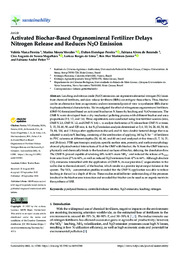Activated biochar-based organomineral fertilizer delays nitrogen release and reduces N2O emission.
Activated biochar-based organomineral fertilizer delays nitrogen release and reduces N2O emission.
Author(s): PEREIRA, V. V.; MORALES, M. M.; PEREIRA, D. H.; REZENDE, F. A. de; MAGALHÃES, C. A. de S.; LIMA, L. B. de; MARIMON-JUNIOR, B. H.; PETTER, F. A.
Summary: Leaching and nitrous oxide (N2O) emissions can represent substantial nitrogen (N) losses from chemical fertilizers, and slow-release fertilizers (SRFs) can mitigate these effects. Thus, biochar can be an alternative from an agronomic and environmental point of view to synthesize SRFs due to its physicochemical characteristics. We investigated the effect of nitrogenous organomineral fertilizers (OMF-N) formulated based on activated biochar on N losses by leaching and N2O emissions. The OMF-N were developed from a dry mechanical pelleting process with different biochar and urea proportions (2:1; 1:2, and 1:4). Three experiments were conducted using four fertilizer sources (urea, OMF-N 2:1, OMF-N 1:2, and OMF-N 1:4): i. to analyze the kinetics of N release from OMF-N at times: 5, 15, 30, 60, 90, and 120 min; ii. for N2O emission analysis determined at 3, 6, 10, 14, 24, 44, 54, 64, 74, 84, 104, and 118 days after application to the soil; and iii. for a double factorial design that was adopted to analyze N leaching, consisting of the combination of applying 160 kg N ha−1 of fertilizers in PVC columns at different depths (20, 40, 60, and 80 cm) and analyzed at five times (1, 7, 14, 21, and 28 days). FTIR spectroscopic analysis, specific surface area, porosity, and surface morphology showed physicochemical interactions of N of the OMF with biochar; the N from the OMF interacts physically and chemically binds to the functional surfaces of biochar, delaying the dissolution flow. The OMF-N proved capable of retaining 48% to 60% more NH4 + and reduced the release of Ntotal from urea from 27% to 60%, as well as reduced N2O emissions from 47% to 66%. Although absolute CO2 emissions intensified with the application of OMF-N, its use provides C sequestration in the soil to due to the recalcitrant C of the biochar, which results in a positive input-output balance in the system. The NO3 − concentration profiles revealed that the OMF-N application was able to reduce leaching in the soil to a depth of 80 cm. These studies enabled better understanding of the processes involved in the biochar:urea interaction and revealed that biochar can be used as an organic matrix in the synthesis of SRF.
Publication year: 2022
Types of publication: Journal article
Unit: Embrapa Forestry
Observation
Some of Embrapa's publications are published as ePub files. To read them, use or download one of the following free software options to your computer or mobile device. Android: Google Play Books; IOS: iBooks; Windows and Linux: Calibre.
Access other publications
Access the Agricultural Research Database (BDPA) to consult Embrapa's full library collection and records.
Visit Embrapa Bookstore to purchase books and other publications sold by Embrapa.

